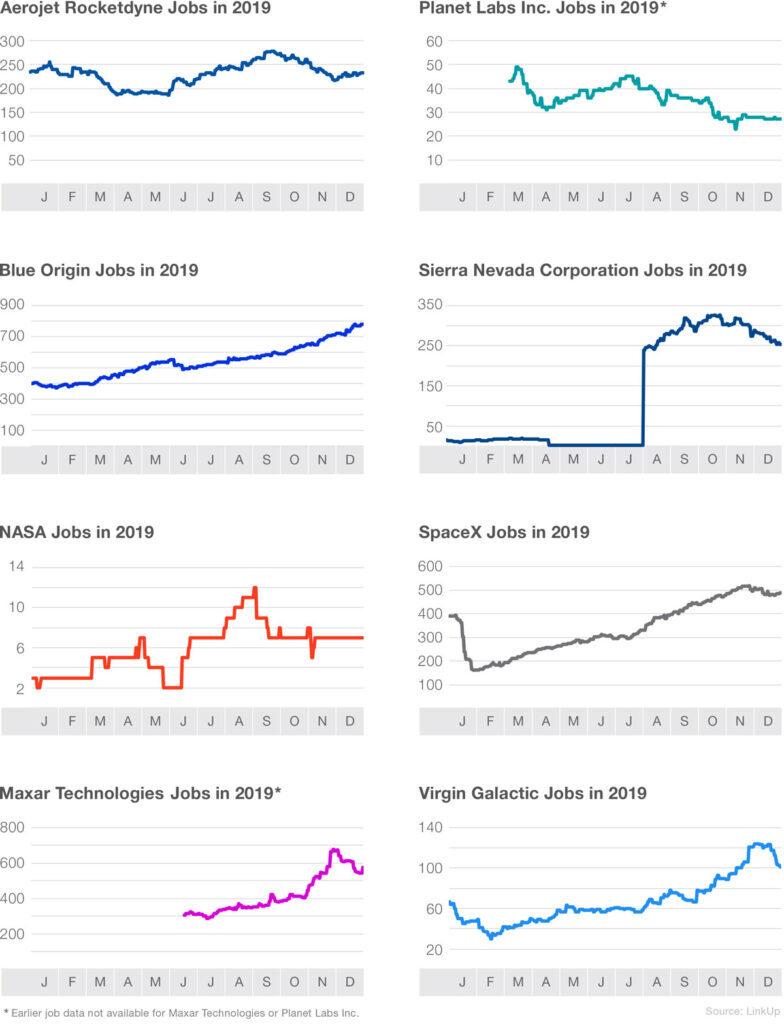Race to space
In 2019, the world saw the first photograph of a black hole. As we start a new decade, we’re excited to see how much farther we will venture into the unknown, and because we’re in the business of jobs, where space-related job growth will take us.

In 2019, the world saw the first photograph of a black hole. As we start a new decade, we’re excited to see how much farther we will venture into the unknown, and because we’re in the business of jobs, where space-related job growth will take us.
NASA’s highly anticipated Artemis Program, designed to return astronauts to the lunar surface by 2024 and eventually send them to Mars, has already spurred job growth in the form of partnerships with innovative tech and aerospace companies. We recently looked at our jobs data for a handful of innovative companies with their eyes to the skies. Take a peek:

The space economy is an estimated $400 billion market, mostly dominated by huge government-commissioned aerospace companies, but lately other companies have made strides to position themselves for growth. And NASA’s rocket building, lunar landing partners (including Aerojet Rocketdyne, Blue Origin, Maxar Technologies, Sierra Nevada Corporation, and SpaceX) aren’t the only companies lined up in the race to space.
Space tourism companies are preparing for launch too. In October, Virgin Galactic became the first publicly listed space company. Their jobs fluctuated in 2019, but overall jobs increased by 51%. This year they aim to launch Branson into space and start operating commercially, expecting to be profitable by 2021.
Others have their sights set a bit closer to home. As the small satellite market grows, companies are competing to fill jobs, and the sky. (At this rate there are fears that satellites will soon outnumber and outshine the stars!)
SpaceX alone has 182 spacecraft in the sky at the moment, and plans to launch 42,000 satellites. Growth and hiring continues as they have a variety of big and interesting projects in the works—from broadband internet satellites, defense satellites, to contracts for rocket work (with NASA and others), and even bringing cannabis and coffee to space.
Planet Labs, with about 150 satellites in orbit, is capable of producing 40 satellites a week. Their satellites are used to photograph every part of the earth every day. Recently their images have been used increasing in the media as they have captured everything from secret military movements to parking lots full of grounded planes. We enjoy seeing these before and after photos, and expect to keep seeing movement in their jobs too.
In 2019 we saw jobs flux and grow. Sierra Nevada’s jobs skyrocketed as they completed a new facility, and announced big contracts for their surveillance balloons, light-attack planes for the Air Force, plus their lunar lander for NASA. Blue Origin jobs listings increase by 93% in 2019, and SpaceX jobs listings increase by 25%.
We’re eager to keep our eye on all of these companies, and their jobs, as the year unfolds. If you’re as interested in the data as us, let us know!

(Featured image: “The Martian” from 20th Century Fox)
Insights: Related insights and resources
-
Blog
04.09.2020
The LinkUp 10,000 Dropped Another 1% Again Yesterday
Read full article -
Blog
01.13.2020
Welcome to the future
Read full article -
Blog
04.09.2019
March jobs spring into a familiar seasonal pattern
Read full article
Stay Informed: Get monthly job market insights delivered right to your inbox.
Thank you for your message!
The LinkUp team will be in touch shortly.
